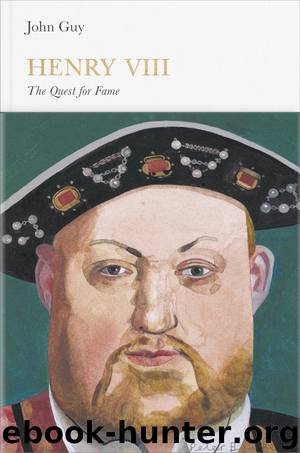Henry VIII (Penguin Monarchs) by John Guy

Author:John Guy
Language: eng
Format: epub, azw3
ISBN: 9780141977133
Publisher: Penguin Books Ltd
Published: 2014-10-16T16:00:00+00:00
5
A Second Solomon
Like King Solomon, the most famous of the Old Testament patriarchs, who was said to have sat in majesty on an ivory throne and who completed the building of the First Temple in Jerusalem, Henry regarded magnificence as a political weapon. His father was the earliest English ruler to employ Italian sculptors on royal building projects, such as his dynastic mausoleum in the Lady Chapel of Westminster Abbey, but Henry was the first to drag the monarchy kicking and screaming into the mainstream of the European Renaissance.
He dressed to impress, spending up to £4,000 a year on clothes at a time when his personal tailor, John Malt, earned as little as 12 pence a day (in old, pre-decimal currency). Apart from robes of state, his wardrobe contained 79 thickly bejewelled gowns, many with collars of lynx, sable or squirrel fur, 86 coats and 134 doublets made from 29 types of fabric, including 25 of velvet, 23 of ‘tilsent’ (a prohibitively expensive silk cloth interwoven with flat gold or silver metallic strips) and 17 of satin. Sometimes he wore contrasting colours, at other times the same, as on May Day 1510 when he burst into Katherine of Aragon’s bedchamber, dressed all in green like Robin Hood and clutching a bow and arrow, or the day the news of Katherine of Aragon’s death broke, when he and Anne Boleyn put on matching yellow satin.1
A compulsive purchaser of accessories, he got through in a single year 200 shirts, 37 hats, between 65 and 146 pairs of hose, 60 pairs of socks and 175 pairs of satin shoes, velvet slippers and leather boots. His finest embroidered shirts were given as New Year’s gifts and his daily linen sewn for him by the wives of humbler courtiers. Katherine of Aragon lovingly made him shirts – even after he had told her that their marriage was over. Anne Boleyn refused, hiring a shirt maker instead.2
Henry was a conspicuous consumer of art and culture rather than a genuine connoisseur like Francis I of France. He accumulated things chiefly because he could – and he did so indiscriminately, acquiring the costliest items more as stage props than for their intrinsic appeal. Visiting dignitaries would be given conducted tours of his treasures. Occasionally he showed them off to the public. In 1527, he threw open the doors of a temporary banqueting house at Greenwich for three or four days, so that ‘all honest persons’ could admire a display of his most prized tapestries, along with two gigantic cupboards stacked high with his finest gold and silver plate.3
Henry kept smaller collectors’ objects in his private studies or in cabinets in the privy galleries at his palaces. Among them were exotic items such as pietre dure cups and jugs, Venetian glass, alabaster figures and table ‘jewels’ created as conversation pieces. These might include fish, birds, boats, scallops or snails made of rock crystal or mother-of-pearl, set with gold or silver, rubies, diamonds and pearls. Also kept in cabinets were
Download
This site does not store any files on its server. We only index and link to content provided by other sites. Please contact the content providers to delete copyright contents if any and email us, we'll remove relevant links or contents immediately.
| Africa | Americas |
| Arctic & Antarctica | Asia |
| Australia & Oceania | Europe |
| Middle East | Russia |
| United States | World |
| Ancient Civilizations | Military |
| Historical Study & Educational Resources |
Room 212 by Kate Stewart(4742)
The Crown by Robert Lacey(4578)
Endurance: Shackleton's Incredible Voyage by Alfred Lansing(4514)
The Iron Duke by The Iron Duke(4126)
The Rape of Nanking by Iris Chang(4024)
Killing England by Bill O'Reilly(3900)
Joan of Arc by Mary Gordon(3792)
Say Nothing by Patrick Radden Keefe(3731)
I'll Give You the Sun by Jandy Nelson(3275)
Shadow of Night by Deborah Harkness(3181)
Hitler's Monsters by Eric Kurlander(3170)
Mary, Queen of Scots, and the Murder of Lord Darnley by Alison Weir(3072)
Blood and Sand by Alex Von Tunzelmann(3060)
Darkest Hour by Anthony McCarten(3019)
Margaret Thatcher: The Autobiography by Thatcher Margaret(2972)
Eleanor & Park by Rainbow Rowell(2947)
Red Famine: Stalin's War on Ukraine by Anne Applebaum(2817)
Book of Life by Deborah Harkness(2726)
The One Memory of Flora Banks by Emily Barr(2687)
